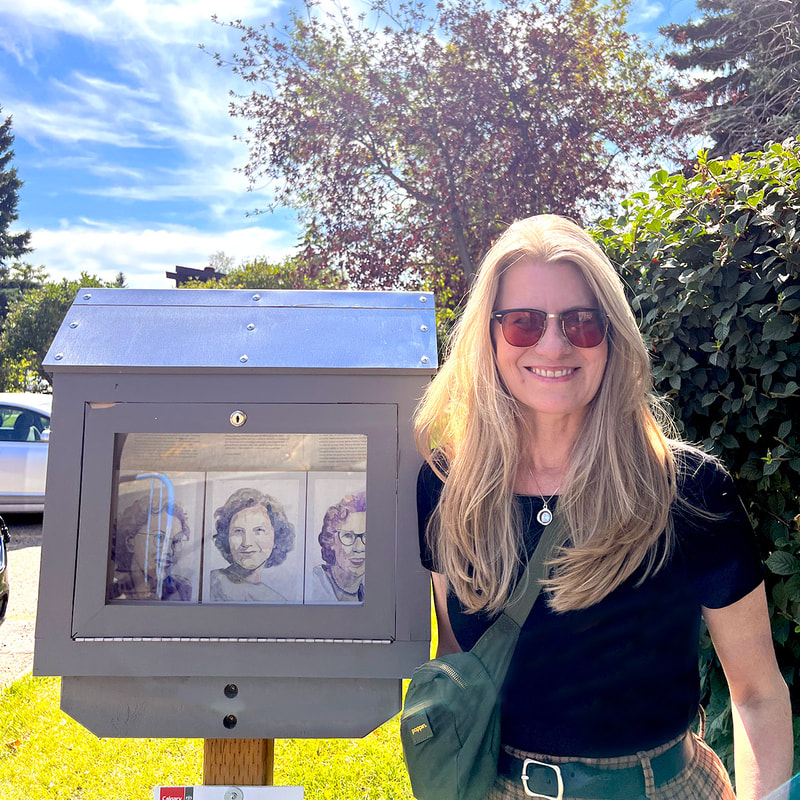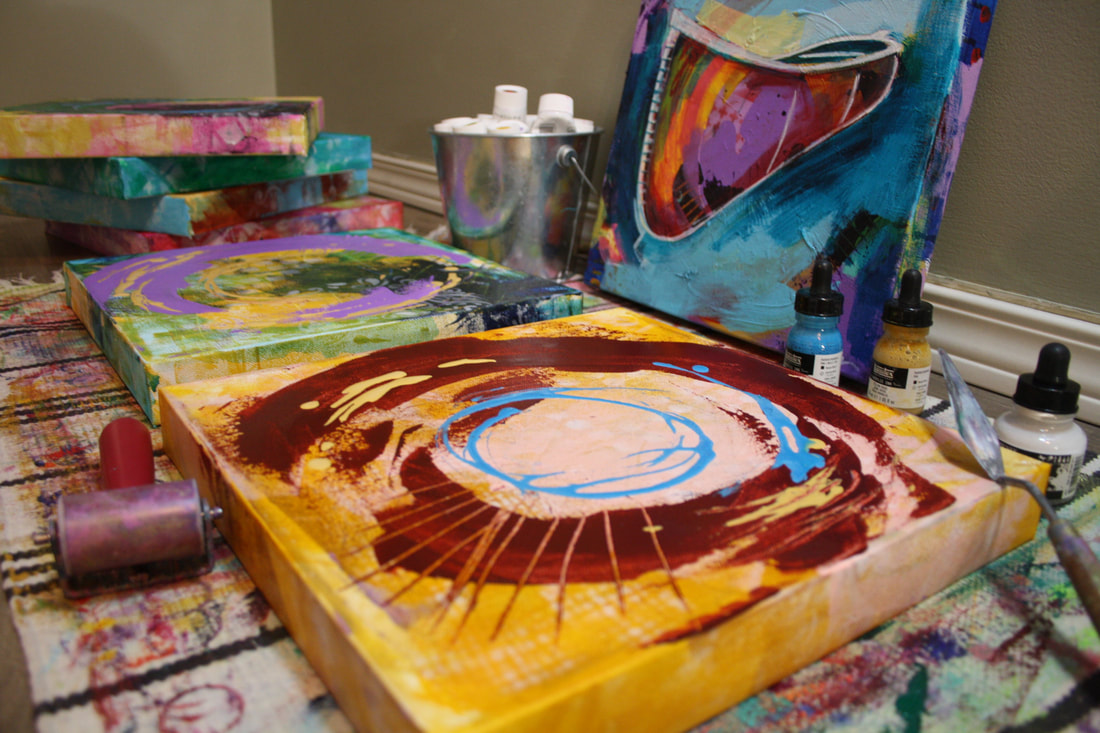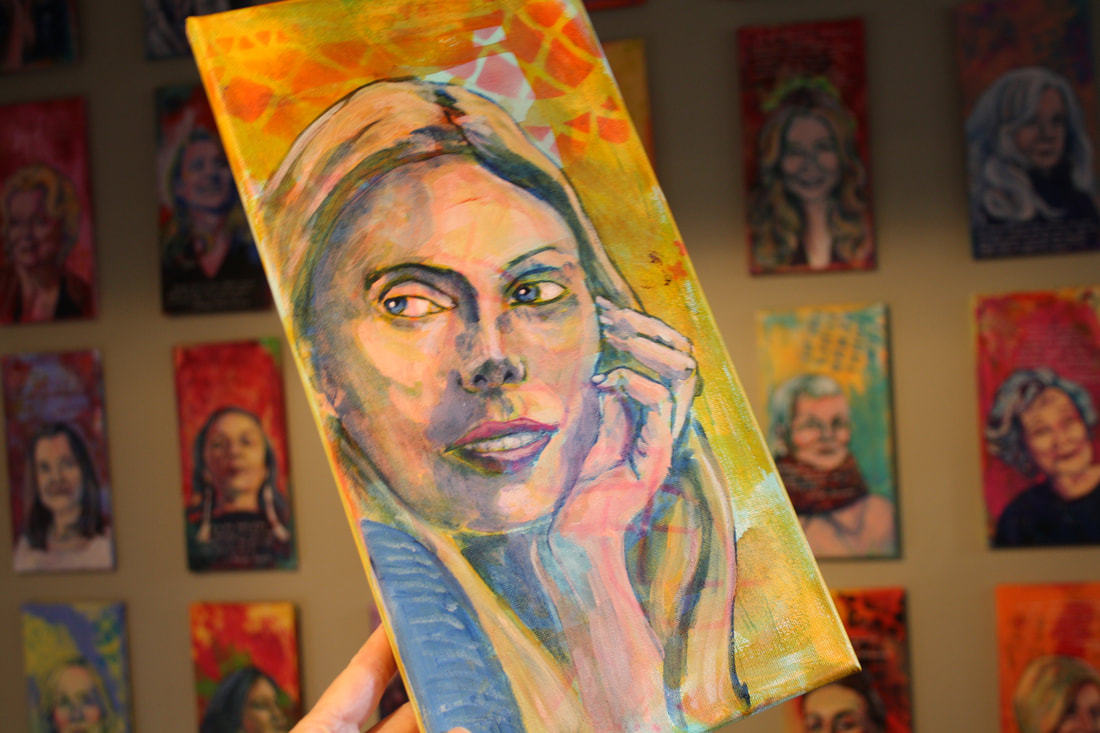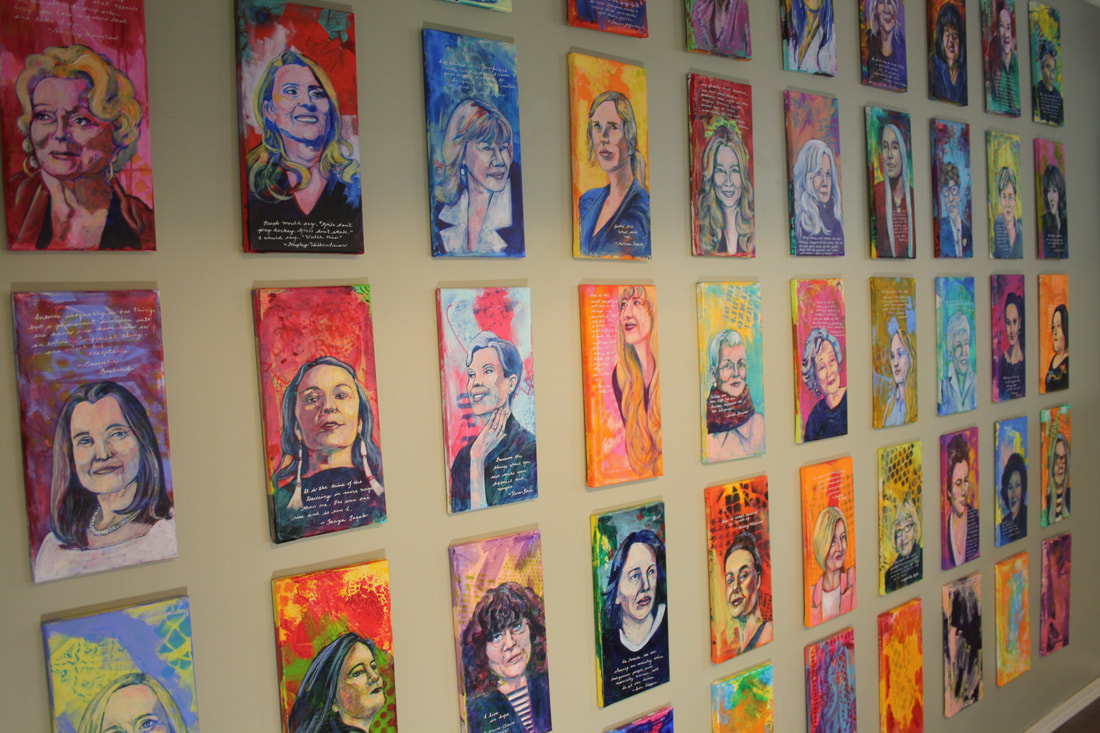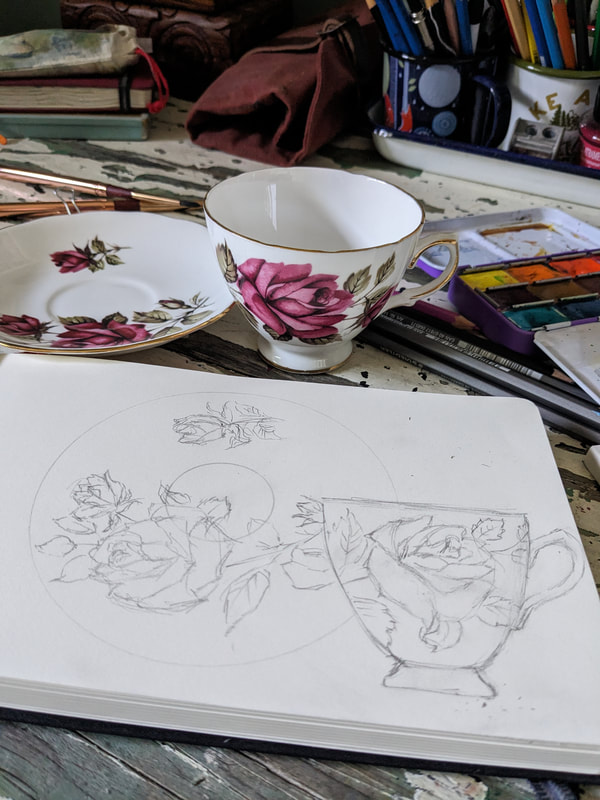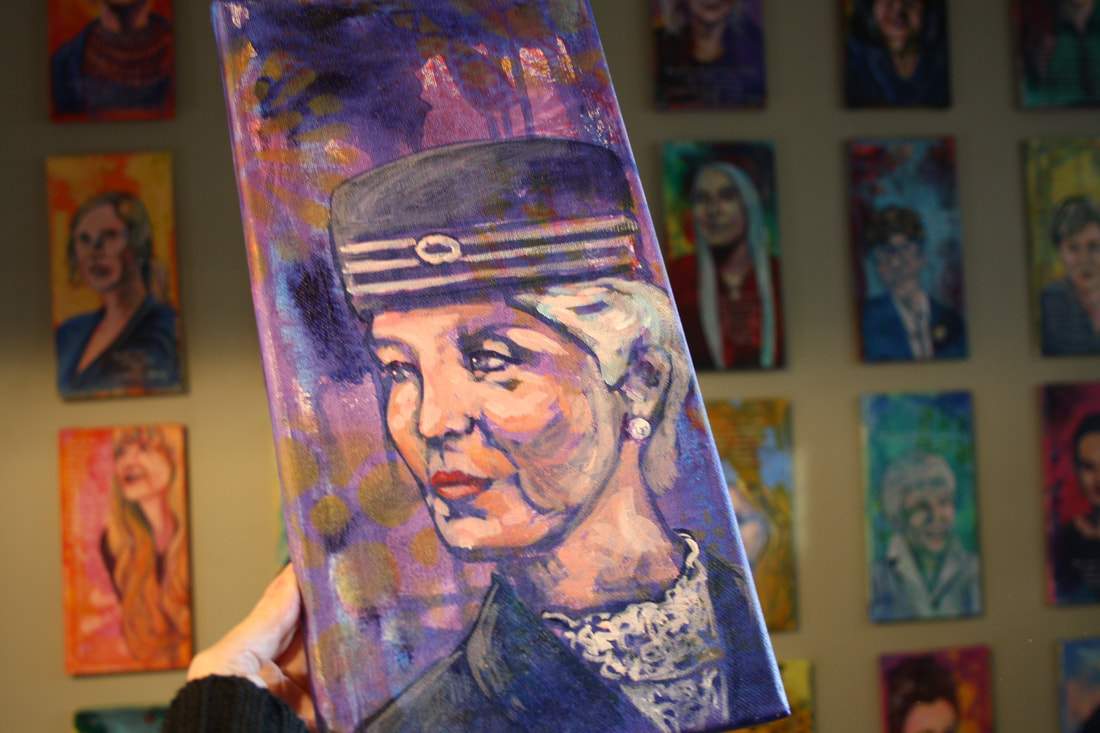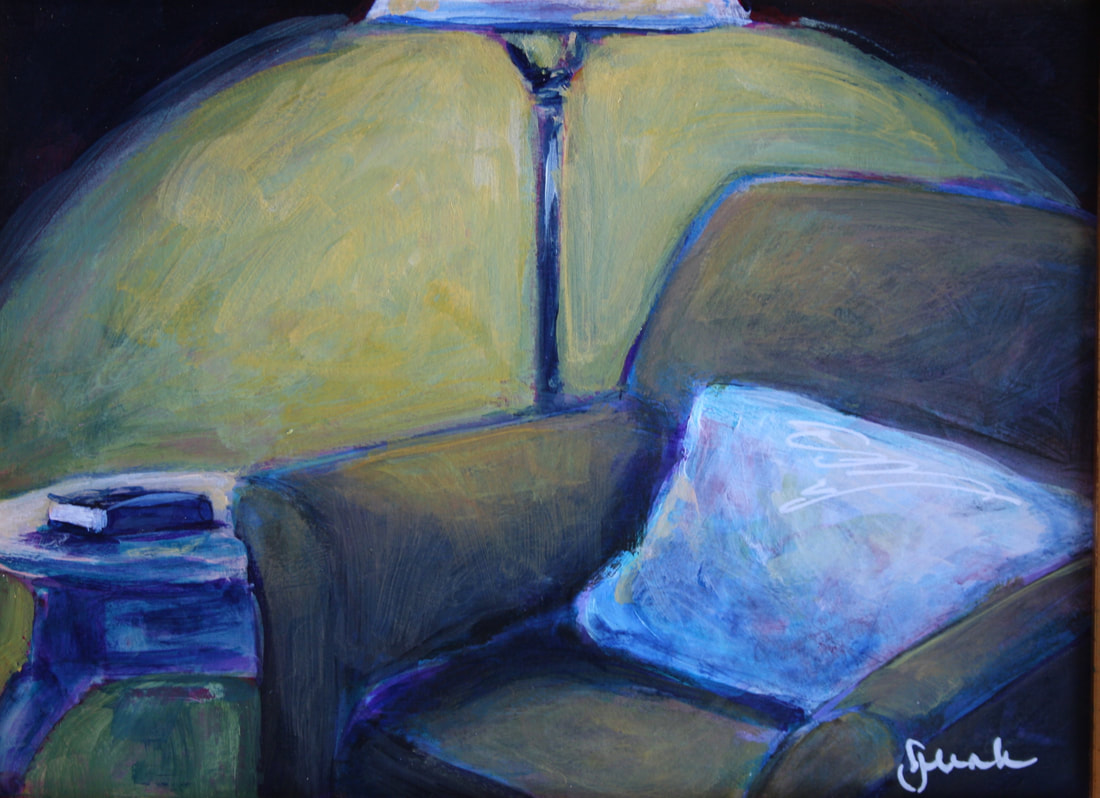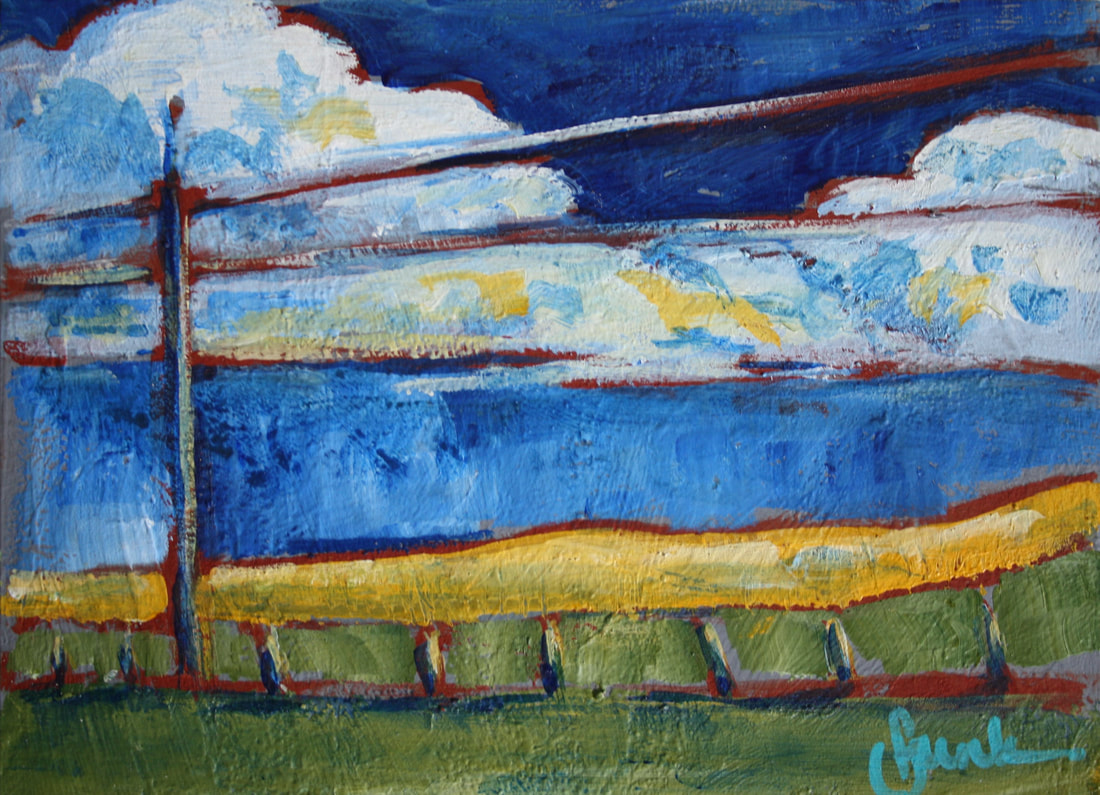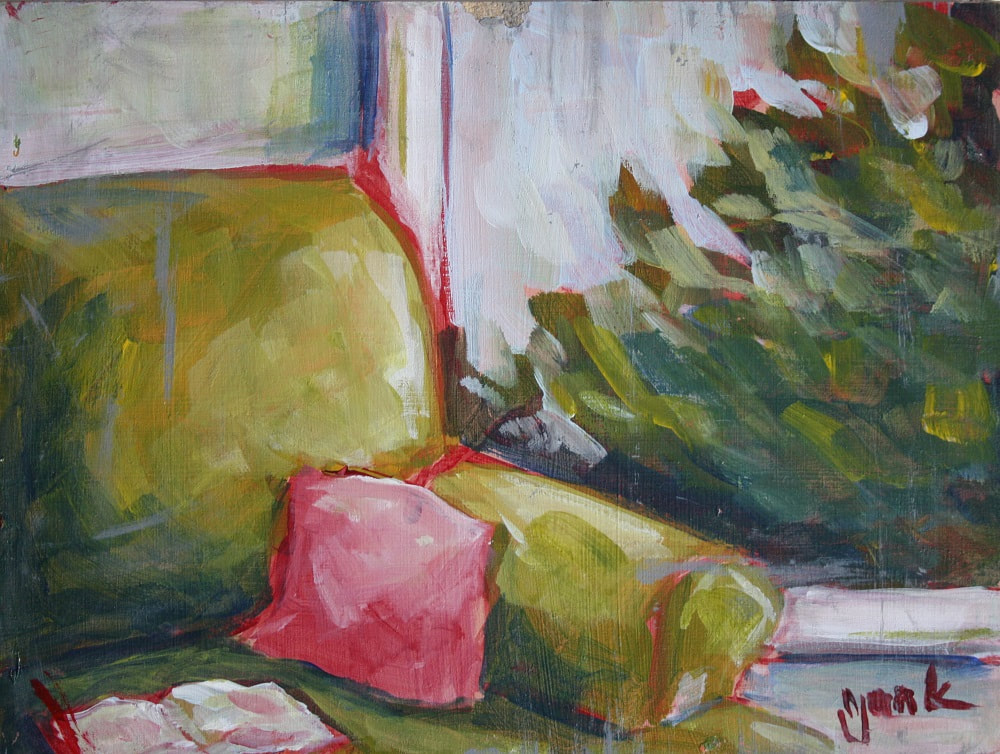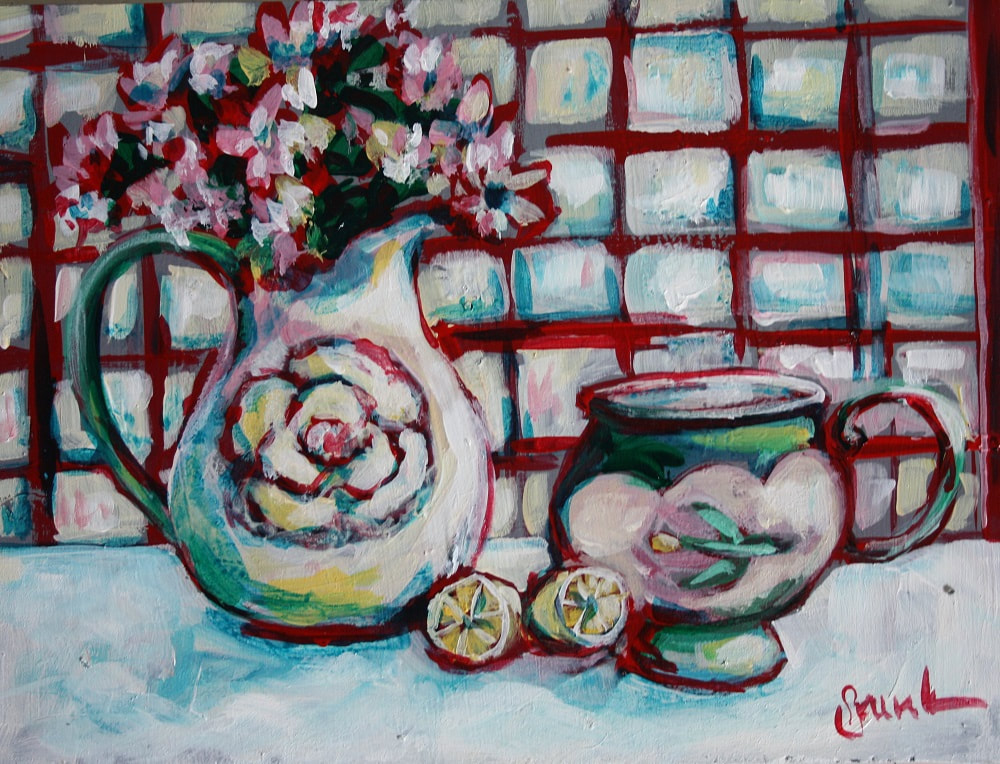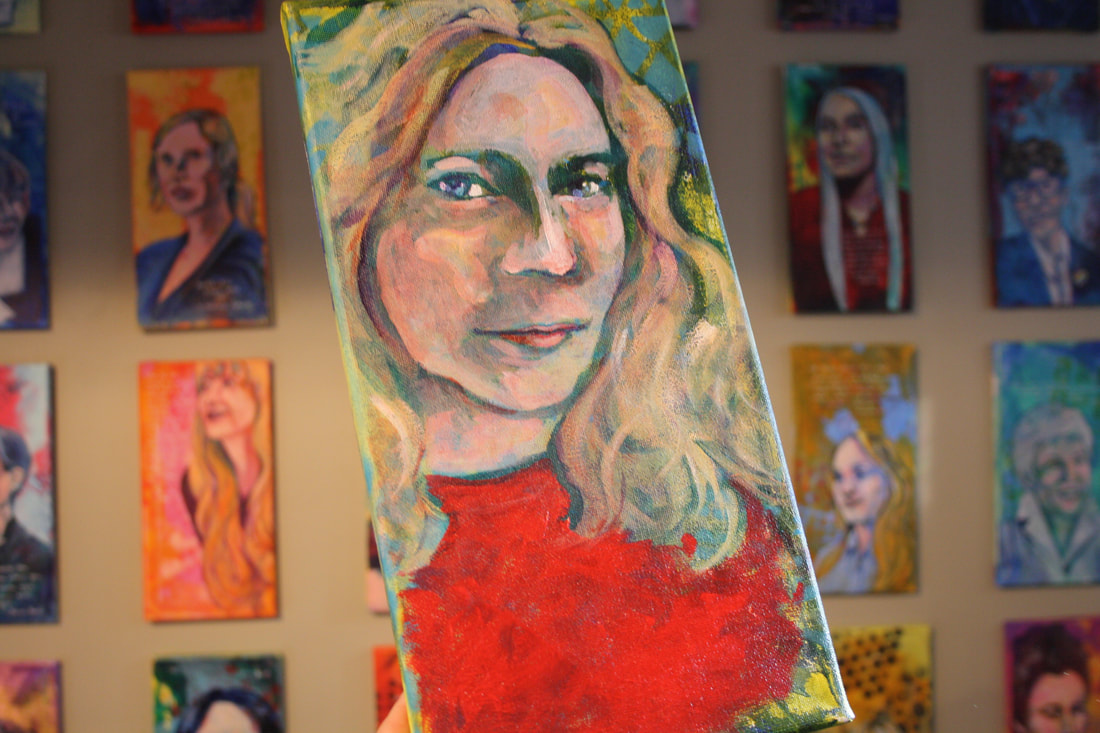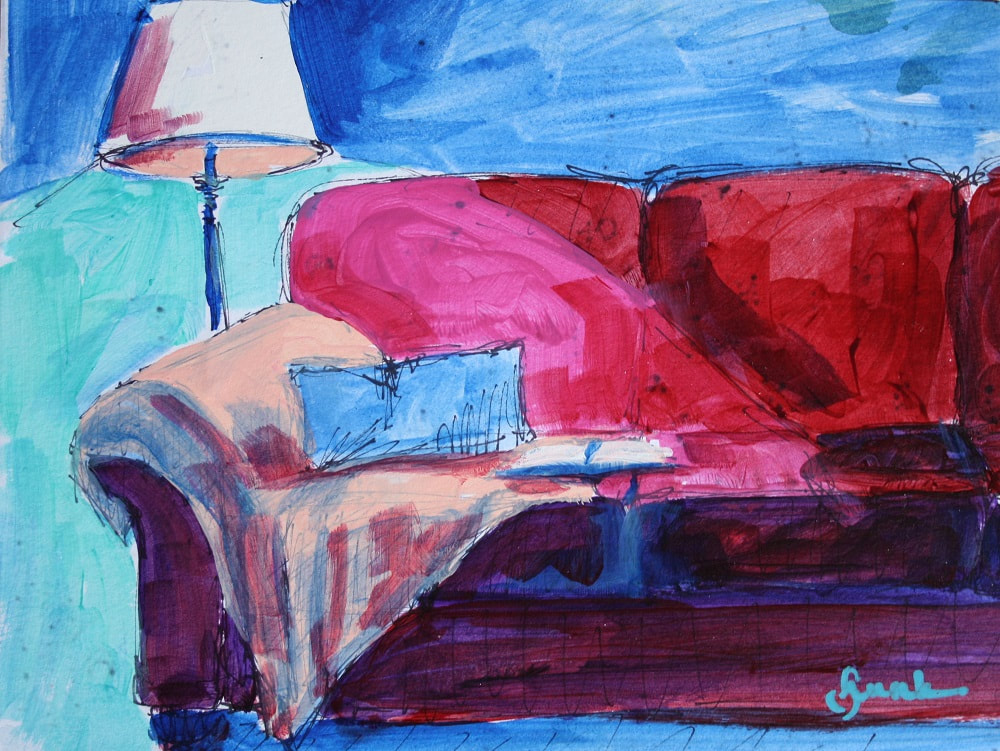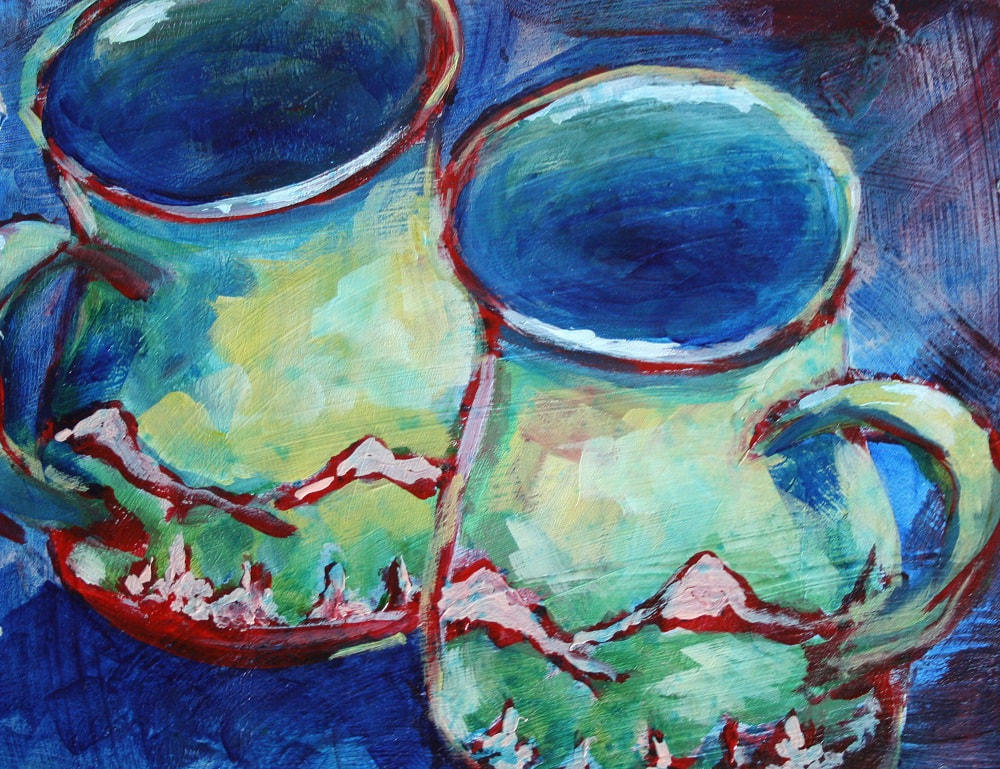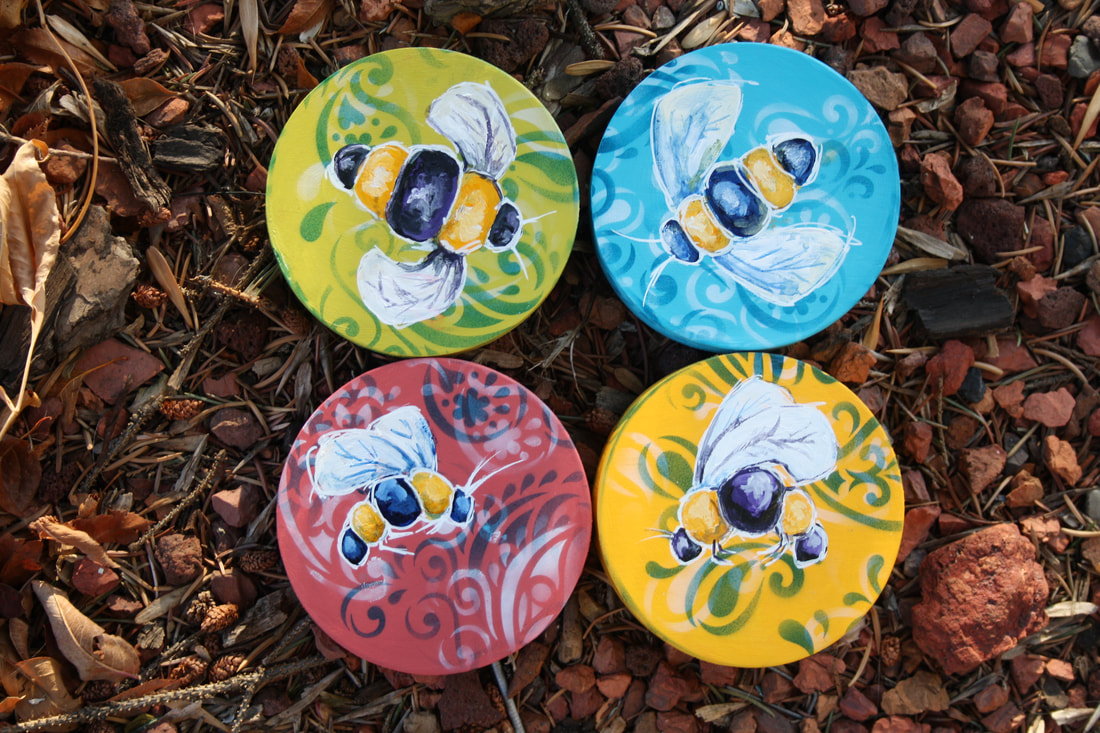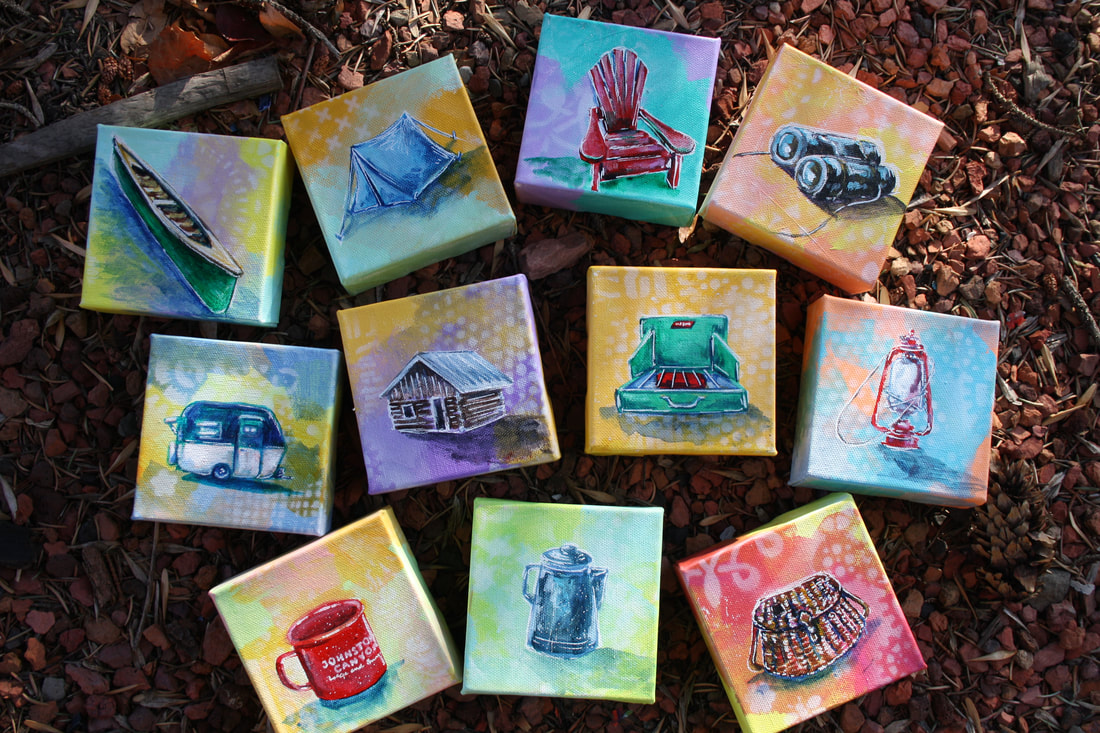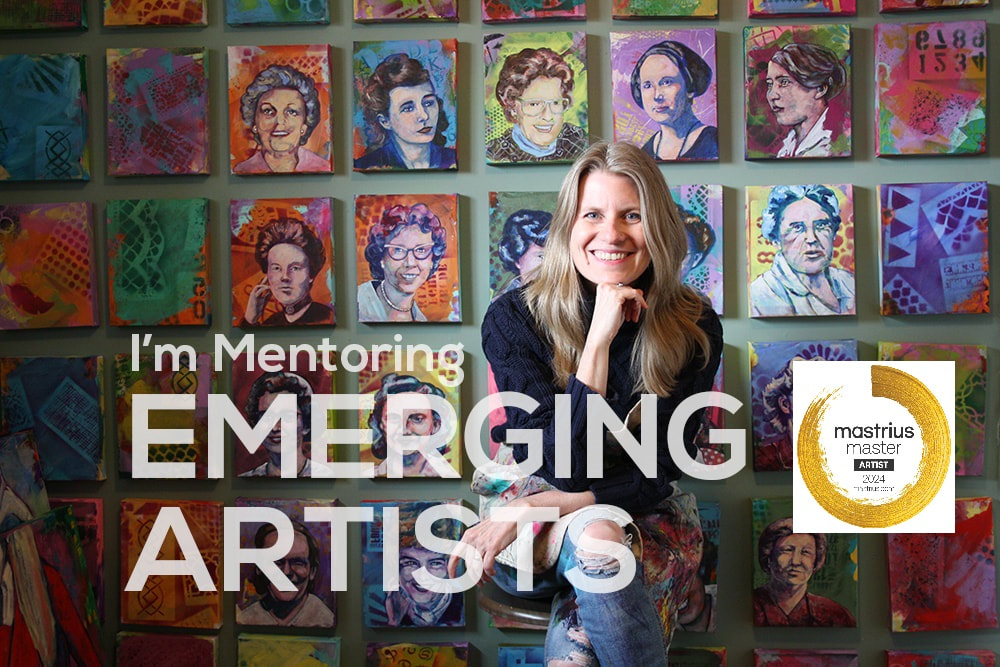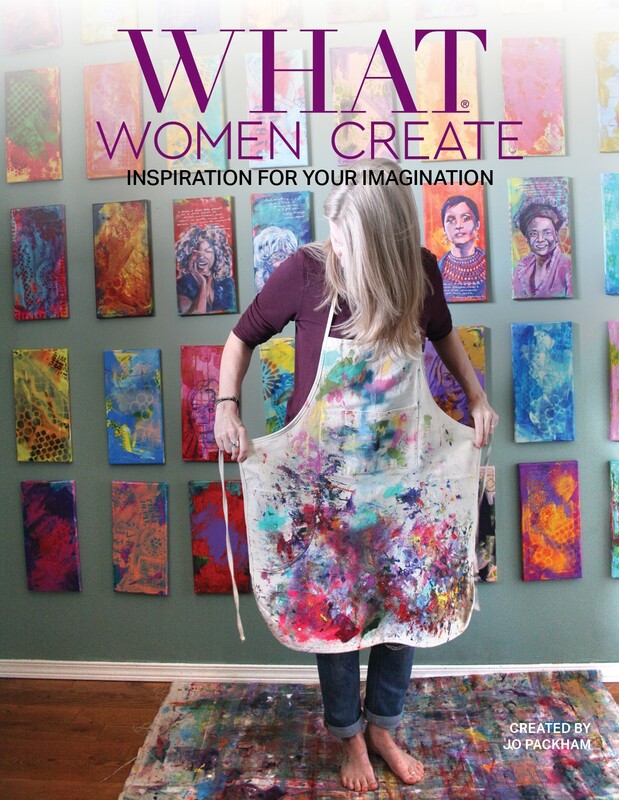|
Well...another year and another project completed. I'm so pleased. 52 'Extraordinary Canadian Women' on my wall and, yet, there are so many others I would still love to paint. This is always the best way to celebrate the year and, though I'm still looking for more women for my next project 'Woman's Work', I am excited to begin anew. I always feel as though I learn something new, not only about the women I paint, but also about myself as a person and an artist. That is one of the best parts about painting these portrait projects. There is a book now available here and I'm hoping to find a space to exhibit these women in 2022. Thank you for words of support and encouragement throughout the year and HAPPY NEW YEAR!
I may change styles and things, but the core of who I am, never. Joni Mitchell was born in Alberta, Canada, in 1943. She lived in a series of small towns, contracting polio during the epidemic of the 1950s that left her with scoliosis and limited strength in her left hand. Bored by schoolwork, she taught herself music, using modified fingerings on the ukulele and guitar because of her left hand difficulties, and immersed herself in poetry and painting. At 17, she moved to Toronto and played and sang in coffee houses, eventually performing in New York. She met the folk singer Chuck Mitchell, whom she married, and whose name she has kept.
She was signed to Frank Sinatra’s Reprise label in 1967, beginning a career that has spanned more than 50 years, 19 studio albums, and nine Grammy Awards – including a lifetime achievement award. Her early albums were dubbed “folk” by reviewers as Mitchell notes, “they just saw a girl with a guitar and to them, that meant it had to be ‘folk music’”. Now considered among the most important songwriters of the past six decades, she has spent her career exploring different styles, which led her own record company at one point to sue her for turning in music that was not “Joni Mitchell-like”. Mitchell and I met in the 1990s through the Grammys, and we became friends. Over the past 25 years, we’ve played our new songs for one another, played pool, eaten stir-fry from her wok, and attended concerts together. I wrote parts of my past three books sitting in her garden, while she worked in her studio and painted. She is an attentive reader and teacher, generous with practical and conceptual advice about songs, science writing, and love. Daniel Levitin You’ve been painting a lot since I last saw you. Are you still writing music? Joni Mitchell I always considered myself a painter first. When I was 20, that’s what I wanted to be. I sort of got into music as a lark, with [my first husband] Chuck Mitchell. I never thought I’d make any money from music. DL Painting is very solitary, and music much less so. It doesn’t have to be, but you’ve surrounded yourself with some of the best musicians there are – Herbie Hancock, Wayne Shorter, Tom Scott… JM Well I started out wanting to be in complete control. On my first record, the credit reads “produced by David Crosby”. But he didn’t produce it. The record company didn’t trust me at all – but they trusted him because of the Byrds. So we told them that he was going to produce it, and he just made sure that everyone stayed out of my way. Then for all those years, it was just me and Henry Lewy in the studio, with me producing and Henry engineering. DL But at some point, you really were collaborating with other musicians, like Jaco Pastorius and Charles Mingus… JM Those were very different collaborations, of course. Jaco did what he wanted. He was very independent. He was the first bass player I ever worked with who realised that he didn’t have to play the root of the chord. I didn’t even know what a root was! With Charles it really was more of a one-to-one collaboration. He had these songs and he asked me to put words to them. I spent a wonderful time at his apartment facing the Hudson, and his wife Sue would go out and make us tea and we’d be working and then take breaks and just talk and talk. DL I love the story of how you came to write your ballet, The Fiddle and The Drum. JM (Laughs.) Well, you know, I loved Prince’s music, and he came up to me at the Grammys and said, “You really should write some dance music.” He didn’t say what kind of dance, so I wrote a ballet. DL You seem to be working all the time. At one point about 16 years ago, when you were 61, you were working on a ballet, preparing a new set of multimedia art about war, and recording an album. And your involvement in all of these was intense. You had a hand in the choreography and stage design for the ballet, you got involved in the lighting and staging at the art gallery. You played me one song several times over a six month period and you still weren’t finished – you kept tinkering with it to get it right. JM The problem is that most people in the business of bringing art to the public, the people who exploit artists, lack imagination. And they just want to do what’s worked for them in the past. If I’m not involved, it won’t get done right. And it’s my work. I know what I want and I’m not afraid to stand up for the work. People misinterpret this. They think that I have an inflated sense of ego, that I’m saying I’m smarter or better than they are. I’m not standing up for myself, I’m standing up for the work, being its advocate and caretaker. And with the songs, well yes. It’s always like peeling back the layers of the onion. I keep peeling and peeling until I get to the real truth, the real core of what I’m trying to say. People misinterpret my lyrics, they project them on to me as autobiographical, psychological revelations. But they’re not. I’m really the playwright and the actress. The songs aren’t about me. I’m writing and singing in the first person, but they’re not all about me. I’m giving voice to a character, to a set of feelings. And to explore that character and those feelings, just like a playwright, I need to keep at it, keep working at it until I know it’s right. Sometimes that means revising the music, sometimes the lyrics, sometimes the presentation, the mixes, the whole thing. DL Donald Fagen said that he and Walter [Becker, his co-writer in Steely Dan] never talk to journalists or anyone else about what the songs mean or where they come from. They’re just ther to bring their own interpretation to them, and they want to keep it that way. JM I don’t know if he really feels that way or is just trying to be obscure or provocative. I bet he doesn’t really feel that way. My songs are about very specific things and people often get them wrong. Like you did with “Amelia”. DL To me, the narrator was singing about a lover, with whom she is realising she is really not in love – the “false alarm”. So many of us can identify with that – thinking you’re in love and then realising you’re not. And the metaphor for all this – an alarm – is so apt, because love does feel like bells going off, fire alarms, sirens… It’s as though the character is saying, “Those bells that were going off in my heart were wrong, this isn’t love.” In my defence, David Crosby and, well, just about everyone I know, understood it that way. JM Just because it’s common doesn’t make it correct! Look. The false alarm was the end of a relationship. We were both Scorpios and, you know, we cling to things. We couldn’t let each other go. It was done, but we couldn’t let go. We felt we belonged to each other. That whole relationship was winding down and I was driving solo without a driver’s licence across the country. I thought of Amelia Earhart and her solo flight. I can’t remember how many hotel rooms later the song was complete. DL That is a thread I see in your life – you keep working at something until you’re happy with it, never mind that someone else might be happy with less. JM Well, I’m not writing or painting or doing any of the things I do to please other people. I don’t know what they’re going to like or not like. My spirit guide reminds me I am not in their heads. I have to be satisfied with it. And I’m harder on myself than anyone. I didn’t write for years because every time I started to write, I gave myself a block. I’d go “been there, done that” or “I don’t want to write social commentary” or “I don’t want to do this” – and finally I just got so angry at this routine that I had to use my old catharsis method. I had to get it out, but I wouldn’t want to put out just raw anger. Some might say, “Ooh, how powerful!” but it doesn’t do any good. So in the process of tempering, tampering, tinkering with it, you learn; you educate yourself. Working through your crap, trying to make it suitable and subtle. It’s not that you whitewash it, but it’s like you look for the magic mushroom in the turd. Or something like that that’s useful. You try to find the transcendental point of your own mishegas [craziness] so to speak. What are you working on these days? DL Well, since I saw you, I’ve been working on my new book Successful Aging [published in the UK as The Changing Mind]. JM So what can we do to age better? DL Well, one of the things is to avoid getting hit in the head when you’re a kid, or having a stressful childhood. JM Too late for that! (Both laugh.) DL Right. But if you’re already older, staying active socially, like you do, is crucial. JM That makes sense. My dad lived to be 100 and my mom lived well into her nineties. Dad’s goal was to go out on his 100th birthday – and he did. He was golfing. He shot his age three times. At 82 and at 83, and then on his 100th birthday, he shot his age, and he died that day. Both of my parents were very physically active. They went cross-country skiing, did a circle walk every day of a mile around the house. My mother was nutritionally savvy so that had that going for them too. I basically eat a soup and a salad a day. DL A soup and a salad a day? Is that all? JM And porridge for breakfast. You’ve seen my pantry – whole grain oats, those Irish oats for breakfast. Vegetables and fruits. DL And physical activity helps us age better, like you do. JM Yes, and I’ve been doing more lately. I have been swimming a lot. I’ve had this pool for 45 years and that keeps me in shape. And I do a lot of climbing of stairs. You know, it’s a three-storey house so there are lots of stairs outside of the house, and then a lot more inside. I play ping pong too. DL Until recently you drank a lot of coffee and smoked a lot of cigarettes. You often stay up all night. JM I’ve always been a night owl. That’s when I get the most done. When no one’s around. It’s quiet. There’s a special solitude and spirit to the night. I’m a child of the night. DL Herbie Hancock told me something interesting about the way that Wayne Shorter plays. You know how we both like those short bursts of notes he plays, like a bird? JM Yes! I love that. He plays figures, these beautiful little figures. DL Well, you know how he has asthma. Herbie said that Wayne played those little figures because of the asthma – he didn’t have the wind capacity to play long notes and long, legato passages. JM He played some long notes on my records. DL Yes, that’s true, but I think that’s because of the asthma, he couldn’t rely on always being able to do that, so he came up with this other way of playing, because of his limitations. JM Like I do with my singing. DL Or like you do with your guitar playing. The fact that because of the polio, you can’t use all five fingers of your left hand with equal force and dexterity to play the chords other players do, so you invented your own chords inside your own tunings. JM You work around your handicaps. Out of handicaps comes style. ~ Daniel Levithan, Variety I've been pretty busy (happily so) since art history classes have finished up for this year. The 'Extraordinary Women' project is almost complete and I'm happy for several exhibits in the new year with paintings currently available through:
I'm also grateful to have work included in the following exhibitions:
Finally, I am so excited to be exhibiting 'The Grandmothers' project February 5 - April 2 at
I'm looking forward to mentoring with LevellingUp again in the new year and I am really looking forward to a mini art retreat at the Banff Boutique Inn in February. All this after spending the holidays with my girls. I couldn't ask for more. With change is peace. Iona Campagnolo, broadcaster, politician, lieutenant-governor of BC (b at Galiano I, BC 18 Oct 1932). Iona Campagnolo grew up near Prince Rupert, where she began her career as a radio broadcaster. In 1966 she was elected as a school trustee and served as chairman of the school board for six years. She was elected an alderman in 1972. Two years later she ran successfully as a Liberal in the federal riding of Skeena. Campagnolo was named parliamentary secretary to the minister of Indian affairs and northern development in October 1975 and joined the cabinet of Pierre Trudeau in 1976 as minister of state for fitness and amateur sport. Despite her defeat in the 1979 general election, she remained active in politics and in 1982 was elected the first woman president of the national Liberal Party, an office she held until 1986.
Iona Campagnolo has also had a career as a broadcaster and activist. Beyond Canada, she frequently contributed to current affairs programs on PBS-TV and monitored elections and did human rights work in Africa, Asia and South America. She has been a director of such non-governmental organizations as the North-South Institute, the Southern Africa Education Trust, Project Angola and the International Centre for Human Rights and Democratic Development. Within Canada she was elected the first chancellor of the University of Northern British Columbia in 1992 and served a six-year term. She chaired the Fraser Basin Council, an organization committed to the environmental sustainability of the Fraser River, from its inception in 1997 until her appointment as lieutenant-governor and served as a director of the Arctic Institute of North America until 2001. Among Iona Campagnolo's many honours are honorary doctorates from the University of Northern British Columbia, Simon Fraser University and Brock University; the Order of British Columbia (1998); and 2 aboriginal names: Notz-whe-Neah or "Mother of the Big Fin" and Saan-naag-Kaawaass or "Person who Sits High," from the Tsimpsean and Haida nations, respectively. Earlier in her political career, she was made a Member of the Order of Canada (1973). She was installed as the 27th lieutenant-governor on 25 September 2001. During her 6 years as lieutenant-governor, she was a popular visitor to all parts of the province and a gracious hostess at Government House. On 1 October 2007, she was succeeded by Stephen Point. She moved to her home in Comox, BC, with plans to continue to work to promote human rights and other causes. ~ Patricia Roy, The Canadian Encyclopedia I thought I should share the painting on the back of 'Home II' which is currently being exhibited at the ASA Gallery in Calgary which is titled 'Rolling Clouds'. Like the paintings at Bluerock Gallery in Black Diamond and the one coming up in the new year at the Federation Gallery in Vancouver, it is a framed 6x8 inch acrylic painting on panel and also consists of a second painting on the back. This one is of the landscape surrounding us. On a trip to Cochrane from Airdrie, a storm was brewing and the deep blue sky and fluffy cumulous clouds were so beautiful that I had to pull over onto a gravel road in order to sketch it. I'm not a landscape painter by any means, but I love these rolling hills.
Another one of my two-sided paintings is available at Bluerock Gallery. 'Near the Fire' is currently on the front, and 'Tea Time' on the back so that the image can be switched around anytime. They are framed and painted in acrylic on panel. These pieces have been so much fun!
Trust everyone. Everyone behaves better when they feel they're trusted. Writers intent on finding themselves through their craft may want to take a cue from Canadian author Lisa Moore and get lost instead. “When I am in the midst of writing, I never know what I am doing,” she says. “I am hardly present at all. I really feel like I am lost in the world of the fiction.”
The worlds Moore creates speak to this sense of loss, blurring the lines between then and now. Her story, “All Zoos,” which appeared in the summer issue of Maisonneuve, embodies Moore’s interest in “the elasticity of time: how the main character experiences time, all of time, ever, since the birth of humankind. I thought to myself, I'll try to put all of that in a story, and see what happens.” Moore published her first collection of short stories, Degrees of Nakedness (Anansi), in 1995. In 2006, her first novel, Alligator, was nominated for the Giller Prize and won the Commonwealth Writers’ Prize (Caribbean and Canada region). Most recently, her 2010 novel, February, was nominated for the Man Booker Prize. The Selected Short Fiction of Lisa Moore, featuring old and new stories, is forthcoming this fall. Erica Ruth Kelly: You’re both an accomplished short story writer and novelist. How does creating the universe of a novel differ from creating the universe of a short story? Lisa Moore: I approach both forms the same way when I begin. I try to capture scenes that show my characters speaking, moving, acting. I also want them to experiencing the world they are in through their senses. I want the world of the story or the novel to be alive with smells and images and sounds and textures. The way a character experiences the physical world tells the reader who the character is. This is true for novels and stories both. I have a vague sense that a short story allows for subtler connections, less plot, a more delicate construction; perhaps it is more graceful. And a novel demands support beams and iron girders and math and sledge hammers. But I am guessing at this. Some of the most beautiful novels are delicately constructed...And some short stories are as dense and rich and full of history and social nuance and political satire and humour and heartache as any novel. ERK: In an interview with Prism, you said that "everything about writing a story has to be learned over and over, each time I sit down to write a story." Does writing a story remain a process in which you still feel as though you're figuring out how it works from the beginning? Or do you no longer feel like you're starting from scratch each time? LM: Still starting from scratch. I had the great fortune of teaching the short story at UBC's online Creative Writing program over the last few years, and when I saw how fantastic the stories of my students were I became even more scared to start. I kept thinking, How are they doing it? What I love about writing short stories is how intense the experience is. How deeply I get lost in it, how much it matters to me, how much the world of the story matters while I am writing, how real it becomes, and then, pouff, it's over. A novel has to be grappled with and pushed around and made to work. ERK: In "Melody," from Open, your collection of short stories, there is a passage that refers to memory: "...for the rest of my life, while washing dishes, jiggling drops of rain hanging on the points of every maple leaf in the window, or in a meeting when someone writes on a flowchart and the room fills with the smell of felt-tip marker—during those liminal non-moments fertile with emptiness—I will be overtaken by swift collages of memory." This notion of supposedly innocuous events happening in the present while events from the past creep in repeatedly make its way into your work. Does this point to your understanding of how memory functions? Does your background in visual arts influence the development of this "collage"? LM: I think it's the way memory works, but it's also the way fiction works, I think. Meaning accrues as the scenes accrue and float over each other in the reader's memory. I think it's one of the ways we create meaning. I studied painting and I still paint. It requires looking hard at an object and trying to discover what makes it what it is. Why it caught my attention in the first place. What makes it, say, an apple. What elements of appleness are essential? How ambiguous can an apple be? What if the most essential characteristic of an apple were its colour? Would a slash of red paint capture it? Capture it better, say, than a photograph that might contain extraneous information obscuring its appleness?… These kinds of questions somehow help me when I am writing, or at least I think they do. I think they are concerns that translate into narrative too. What about this character is most essential? Is it the print of her teeth in a piece of French bread when she bites off a hunk? Is it the reflections of houses and telephone poles on the passenger car window sliding over her own reflection, when she is a child, going away from home for the first time? I have to believe as a fiction writer that images, smells, and textures and sounds, voices, contain some kind of meaning that makes stories. ERK: "All Zoos" is also strongly connected to memory, since the story is based on a video you saw of a gorilla that had escaped from the Rotterdam zoo. How did your memory of the video infuse itself into the development of the story? How does memory work within the story? LM: What was most important to me about the experience of the video was the dead time in it, when nothing happened. The stillness, in which intense suspense accrued. It seemed to me that the stillness must be such a huge part of being attacked by a wild animal… since the actual attack would be very quick. ERK: In “All Zoos”, Harry, the narrator, muses that "People mistake evolution for cosmic design, but it's actually pure accident. It was not that man stood up because it would help him survive, but that the standing men were able to step to the side when the glaciers rumbled through"? To what extent do you agree with Harry? Do you think our being here is somewhat accidental? LM: I am not sure, but I guess so. Another way to say it is that we are just lucky to be here. But this passage also points to the kind of man Harry will turn out to be. It is a shadow of the him to come. Is he the kind of guy who just steps out of the way when trouble rumbles through, or does he act? Does he stand up? Stand up to the ape, stand up and be responsible? ERK: I noticed that while Harry knows about many things about the world, like philosophy or the tourist attractions of every city he stays in, he doesn't seem to trust his own sense perception. For example, when he saw the gorilla, "he thought he could smell it"; when the gorilla kisses the glass after a teenage girl puts her mouth to it, "Harry heard the teeth clink against the glass, or thought he heard." Is this a comment on the way some of us are disconnected from our sensual understanding of the world, to the point where we do not fully trust it? Perhaps to the point where what we've experienced intellectually supersedes that which our bodies are experiencing in the present tense? LM: This is a good way to read it. Very insightful. I think I also meant to suggest a distrust of notions of truth: what is true, what is actually happening. Harry is a bit of an unreliable narrator in that he is unsure of his surroundings. Or, perhaps that makes him more reliable. Perhaps he is being honest by questioning his experience. Maybe that is the central conflict of this story. Is Harry reliable? Will he pull through, overcome his selfish life and behave like a hero, or like a human being, at least an ordinary human being. And do the right thing. Has he evolved? Can he overcome the ape in himself? ~ Erica Ruth Kelly, Maisonneuve This painting measures 6x8 inches, is framed and includes 'Comfort' on the front and 'Annie's Too' on the back. It's now available at Bluerock Gallery in Black Diamond along wth another interior 'double' and my 'Get-Away' camping minis and my first round mini 'Bees'. I'm so excited to be catching up on my Art History classes (now that they're almost done!) and am also looking forward to visiting some of my favourite places...especially with the holiday season just around the corner. These small reversible interior paintings have been really special to create over the past year, especially since home has become such an important place. As tired as I've been with school, teaching, writing and painting, I'm also extremely happy - doing my favourite things and knowing that my girls are safe and healthy, too.
|
|
